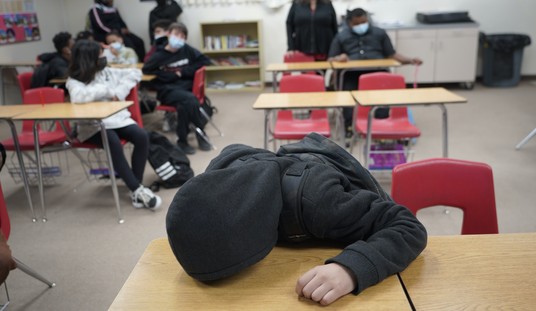"This is what Democracy looks like!" That's the chant we've grown accustomed to hearing when legions of angry Americans have taken to the streets to voice their displeasure and righteous anger over an issue they feel about passionately.
As hundreds of protesters march and let their elected officials know that their passion will translate into votes in the next election cycle, they shout in unison: "This is what Democracy looks like!"
Good! God bless America, the First Amendment, and the brave men and women who have fought and died while wearing the uniforms of the U.S. military to ensure our God-given right of free speech and peaceful assembly.
This IS what Democracy looks like.
Until now, because what we're seeing transpire in our streets and how the recent protests are translating to half-hazard legislative efforts and violent direct action is something very different.
Recommended
Over the past several decades, the organized Left has taken to the streets of America to march, disrupt, chant, and (in some cases) destroy to get attention and media coverage.
The grievances range from the Vietnam War, the Second Amendment, and race issues. Even the conservative-rooted Tea Party movement used marches and protests to voice their displeasure in big government policies like Obamacare and the 2009 tax hike/stimulus package.
Obviously, there is nothing inherently wrong with peaceful protests. But, the latest round of protests surrounding the events that led to the criminal homicide of George Floyd at the hands of a Minneapolis police officer marks a new chapter in American political demonstrations and the opportunistic elected officials who wish to gain political capital from them.
Protest cycles in America often follow the same chronological pattern. Something happens (a school shooting, a horrible example of police brutality, a radical bill that shifts the direction of our country) and people begin to organize. People march in cities across the country, often culminating in one gigantic demonstration that signifies the apex of the movement (often in Washington, D.C.).
Then, lawmakers, governors, and presidents take to the deliberative and transparent process of proposing, debating, and voting on legislation that would address the grievance at hand.
In some cases, weeks after the original flash-point, laws are passed to respond to the anger in the streets. In recent years, school shootings have inspired misguided curbs to the Second Amendment in states like Connecticut, New York, and Maryland, but those laws, thankfully, have not found their way through the federal corridors of power in Washington.
In some cases, nothing happens, and the people are ignored.
I remember the biggest Tea Party protest in March 2010. Angry conservatives spontaneously gathered in Washington, D.C., and let lawmakers hear their loud opposition to the Affordable Care Act.
"This will make health care too expensive!" we screamed. "We will lose our insurance and our doctors!" we warned. "Kill the bill! Kill the bill!" we chanted.
Democrats ignored us. And, oh, by the way, we were right. Medical costs in America skyrocketed, and Barack Obama's outright duplicitous betrayal over "If you like your doctor, you can keep your doctor" will go down in history as an example of why we Americans should never trust a president selling us an obvious bill of goods.
We protested we gathered, we chanted and screamed and, ultimately, we lost. We then cleaned up the park or square or National Mall where we gathered, left it cleaner than it was before we got there, and we went home to fight another day.
And that November we voted Nancy Pelosi and the Democrats out of power in the House of Representatives.
This is what democracy looks like.
What we are seeing right now is something different.
The leadership of the Black Lives Matter movement is doing much more than marching and protesting; they are demanding. They are expecting lawmakers not to take their grievances to the floor of Congress but to drop to their knees in supplication and pledge to meet their demands "or else."
In the District of Columbia, councilmembers held an emergency meeting without any public participation and unanimously passed "emergency" police provisions to respond to the protests that have crippled downtown D.C. for the past ten days. There were no public hearings and no ability for dissenting voices from the citizens of the district.
Protesters disrupted life (and interlopers from Antifa used the protests to cause chaos and destruction) and lawmakers moved quickly to accommodate their demands lest they cause more chaos.
This is not what democracy looks like.
For years activists have called for the removal of confederate statues in Richmond, VA, and other southern cities. In some cases, these monuments have been removed, and in some cases, legislative bodies have decided to keep them. Now, activists have decided to take action and no longer wait for the messy democratic process.
Wednesday in Portsmouth, VA, the city council debated removing a confederate monument in its town square. The council, after thorough discussion and debate, decided to put off the decision until passions and emotions simmered down.
The protesters reacted with vandalism.
The crowd, frustrated by the Portsmouth City Council’s decision to put off moving the monument, switched to throwing bricks from the post that held the plaque they had pulled down as they initially worked to tumble the statue. They then started to dismantle the monument one piece at a time as a marching band played in the streets and other protesters danced.
A flag tied to the monument was lit on fire, and the flames burned briefly at the base of one of the statues.
Eventually, the statues were beheaded and the monument was torn down.
Protesters gathered. They marched, they demanded action.
Duly elected representatives met, debated, and decided not to take that action.
The protesters then took action into their own hands and went ahead and did what their representatives refused to do.
This is not what democracy looks like.
This is what a hostage crisis looks like.
And it has to stop.

























